A trial of an online marketplace to allow customers in Canberra to make the most of their distributed energy resources (DER) has won the backing of the Australian Renewable Energy Agency (ARENA) to the tune of $2.05 million. The $4.12 million project will be run by ACT network operator Evoenergy with the goal to better support the connection of further consumer-owned rooftop solar, home batteries, smart appliances, home energy management systems and electric vehicles.
The trial will integrate Evoenergy’s existing operating systems with GreenSync’s Decentralised Energy Exchange (deX) platform and enroll DER assets into a simulated virtual power plant (VPP). This will allow Evoenergy to better manage DER within its network and in the future allow customers to be paid for providing services to the network through their DER assets.
“Evoenergy’s trial will help to maximise the amount of distributed energy that the network can accommodate, while maintaining the stability of the system,” ARENA CEO Darren Miller said. “This project will utilise two leading industry platforms to demonstrate a coordinated approach to DER management.”
Namely, Schneider Electric will build on its existing Advanced Distribution Management System (ADMS) at Evoenergy with its Distributed Energy Resource Management (DERMs) platform. The platform will work with the ADMS to define and inform which energy resources to despatch to the grid to maximize its performance, and ensure that the network operates within safe operating limits.
In addition, GreenSync’s deX platform will provide additional tools to Evoenergy, including the ability to contract services from VPPs to manage network constraints. The deX platform will also help Evoenergy to facilitate dynamic use of the network, enabling Evoenergy customers to get more out of their assets and export more energy when there is low network congestion.
The future is distributed
Launched in 2018, GreenSync’s deX is designed to help electricity networks better utilize the increasing penetration of DERs and VPPs and allow consumer energy assets to be registered and visible to the grid. It also enables consumers to benefit from selling their generation from assets and appliances such as solar PV, batteries, smart air conditioners, and hot water systems to be used for a range of grid services, including managing frequency, providing energy for the wholesale market and reducing network constraints.
The Melbourne-based energy tech company has previously worked with Schneider Electric on its deX Vision, a portal into the exchange which provides networks and system operators with visibility across the location, performance and operational status of DER, allowing them to understand the net impact of DER in the network. The French company was one of GreenSync’s first partners on the product, providing a bridge to distribution network management systems. Now, the two companies will help define the optimal management of DER in, according to Schneider Electric Vice President Simon Mouat, “one of the most advanced electricity networks in Australia”.
“With ACT’s ambitious renewable energy targets driving the uptake of solar and electric vehicles, this is an ideal network environment for us to demonstrate the growing capabilities of smart energy technology, where customer-owned energy resources can actively participate in providing network services for commercial value,” GreenSync CEO Dr Phil Blythe said.
Last year, the ACT completed its switch to 100% renewable electricity becoming the first major jurisdiction with a population of more than 100,000 outside Europe, and just the eighth globally to complete the transition away from a fossil fuel-based energy supply. Meanwhile, the uptake of DER has been growing rapidly.
“Over the past 10 years we have seen a dramatic increase in the number of distributed energy resources in our network which has changed the way energy flows between homes and businesses,” said Evoenergy Acting General Manager Fiona Wright. “This project is exciting because it will give us a better understanding of how we can unlock the potential of distributed energy resources in an increasingly decentralised grid. We see a future where the role of the network changes to providing a more proactive and flexible platform-based approach to balancing electricity demand and supply, rather than building more poles and wires which is the common solution in a traditional network.”
The ACT project is expected to run for 18 months, with final results being released in early 2021. Across Australia, the number of projects looking to harness the potential of DER has been growing steadily. A market-wide initiative was unveiled this month by the Australian Energy Market Operator (AEMO) with the launch of its DER Register, as the first step in creating a flexible two-way energy system. The platform will provide the operator with a comprehensive overview of the grid-connected resources, allowing it to understand how the swarm of small generators behaves in general and in response to events such as extreme weather and electricity outages.
This content is protected by copyright and may not be reused. If you want to cooperate with us and would like to reuse some of our content, please contact: editors@pv-magazine.com.









1 comment
By submitting this form you agree to pv magazine using your data for the purposes of publishing your comment.
Your personal data will only be disclosed or otherwise transmitted to third parties for the purposes of spam filtering or if this is necessary for technical maintenance of the website. Any other transfer to third parties will not take place unless this is justified on the basis of applicable data protection regulations or if pv magazine is legally obliged to do so.
You may revoke this consent at any time with effect for the future, in which case your personal data will be deleted immediately. Otherwise, your data will be deleted if pv magazine has processed your request or the purpose of data storage is fulfilled.
Further information on data privacy can be found in our Data Protection Policy.